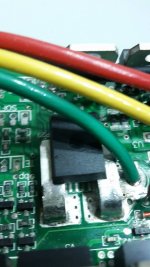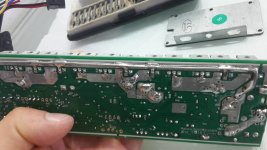I know this is a pretty general question and, if you understand how controllers work, you're thinking "well, where to BEGIN!"
So, maybe instead of a complete lesson on electronics, maybe you can just confirm or correct what I think I know, and fill in the gaps.
The controller has to spin the motor, so to do that it has to provide varying levels current to phase wires. The power mosfets are switched on and off at the appropriate duty cycle to make that happen, and the micro controller has been programmed to know which mosfets need to be turned on, when. The hall sensors read what position the magnets are in, relative to the stator, and this (on-off) signal is read by the MCU as fast as it can manage.
Where I am a little fuzzy is how the MCU turns the appropriate mosfets on, about forward and reverse currents, and what happens when the motor freewheels (throttle zero).
I figure there are 3 (or maybe 6?) I/O... well, outputs, on the MCU which are amplified and fed to the mosfet gates. To turn the power mosfets on, a sufficient gate charge is required. And the right voltage, relative to the drain and source? The signal from the MCU is amplified by using smaller transistors, so that sufficient current gets fed to the gate. Does anyone know, btw, the part number for these smaller transistors for the infineon controllers? I think mine got 'sploded.
What are the capacitors for? The big honkin' ones and the three smaller ones (one per phase) ? What about the teeny tiny capacitors in the gate driver circuitry?
So, maybe instead of a complete lesson on electronics, maybe you can just confirm or correct what I think I know, and fill in the gaps.
The controller has to spin the motor, so to do that it has to provide varying levels current to phase wires. The power mosfets are switched on and off at the appropriate duty cycle to make that happen, and the micro controller has been programmed to know which mosfets need to be turned on, when. The hall sensors read what position the magnets are in, relative to the stator, and this (on-off) signal is read by the MCU as fast as it can manage.
Where I am a little fuzzy is how the MCU turns the appropriate mosfets on, about forward and reverse currents, and what happens when the motor freewheels (throttle zero).
I figure there are 3 (or maybe 6?) I/O... well, outputs, on the MCU which are amplified and fed to the mosfet gates. To turn the power mosfets on, a sufficient gate charge is required. And the right voltage, relative to the drain and source? The signal from the MCU is amplified by using smaller transistors, so that sufficient current gets fed to the gate. Does anyone know, btw, the part number for these smaller transistors for the infineon controllers? I think mine got 'sploded.
What are the capacitors for? The big honkin' ones and the three smaller ones (one per phase) ? What about the teeny tiny capacitors in the gate driver circuitry?






